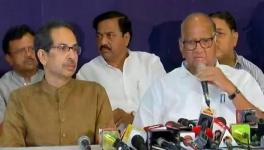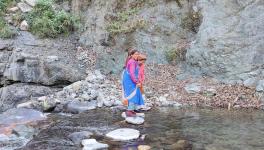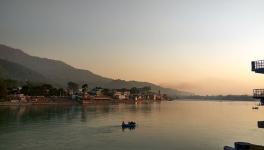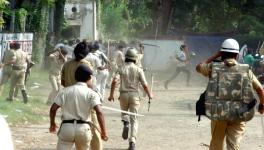Environment as a Survival Imperative
Aseem Shrivastava, environmental economist and activist, exhorts that we should all think about environment as a survival imperative. We can no more relegate the question of environment to the long run. It has to be brought in right now. He strongly feels that land acquisition should stop and there have to be 'no go areas'. Speaking at a round table conference on the challenges facing the NDA government, Shrivastava says that there is no such thing as a civilized society without environmental regulation.
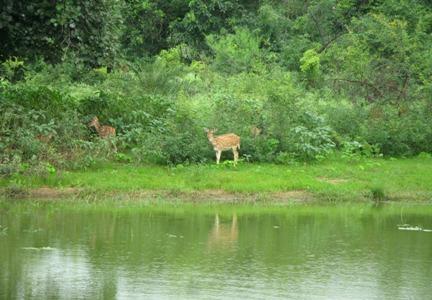
Transcript:
The first thing to accept about the environment is that it is no longer just the environment. The long run is here. We talk about environment as an after though and that is how all policies are being made for a number of decades and centuries. But it is no longer a luxury to think about the environment. It’s actually a survival imperative. A couple of years ago, I was in Bihar and there was a big flood and Chief Minister Nitish Kumar had gone for a helicopter survey. He came back and said, ‘Sookha zyaada serious hai’ (Drought is a more serious issue). So people asked him what you are saying. You went to look at a flood and came out with a drought. Then he said, ‘Nadi mein baad hai. Baaki saara sookha hai’ (The river is flooding and all the rest is dry).
Now can anyone solve this puzzle? It is very simple. The cause is the same. It is climate change. Climate change is causing the drought and also leading to glacial melt which is causing the rivers to be in full spate. So the rivers can flood and the monsoons can fail at the same time and that’s how you have this situation. Last year, the Uttarakhand floods were caused due to the glacial lake melting. The GLOF (glacial lake outburst floods) phenomena lead to the whole Kedarnath-Gaurikund valley flooding out of control and it happened so suddenly that it took everyone by surprise.
So things are happening behind us. We are just looking ahead of us, thinking of economic policy but some almighty is making our environmental policy rather actively behind our backs and we are not paying attention. We cannot relegate certain questions to the long run. They have to be brought in right now. This is my starring point and also my conclusion. And this government like every other previous government is fated for complete failure if it does not integrate environmental and economic policy. Very few governments in the world are thinking of doing that, let alone actually doing it. Some places in Latin America have made a pioneering start but certainly no western country is doing it.
Now moving from there, just to give you some sense of how bad things are, last year Partha Dasgupta issued some data from Cambridge University which showed that since the 1970s, India has been on an unsustainable growth path. Unsustainable, just in the sense of actually not being able to cater to the resources needed for economic growth, let alone human survival in the long run. The World Bank, a year ago, came out with a report which was there in the media for a brief while and not discussed at all. It showed by just looking at a few indicators such as loss of forests, water resources, etc. instead of 25 or 30 different environmental indicators, that India loses 5.7 % of GDP due to environmental losses. Last year, the growth of the economy was 4.5 %. So actually the economy grew negatively at -1.2 %. So if you did green accounting you would realise that the economy has stopped growing for a long time now.
Shall we have a development principle that BRIC nations and developing nations advocate environment regulations aggressively as we have been doing do morally around the world. Let’s say the number of cars in the world is 2 billion and that’s the right number. India has around 20 million cars and that is 1 % of the number of cars. India has 16 % of the world’s population. Should India also have 16 % of the world’s cars? Is that a good principle to start with? Or should it have 8 % of the world’s cars or even 4 % of the world’s cars? Or whether it should have any cars at all? So what is the starting principle?
The second kind of question which one has to ask is one of development. We go and take poor people’s land presuming development. Nonsense! Development has been the biggest lie since 1947. Everyone should know that and accept it. It’s our biggest national lie. Are there conditions under which we will not take people’s land, no matter what? Are there ‘no go’ areas, whether in agriculture or in forests or in water bodies or in pastures? For instance, tomorrow if under ‘7, Racecourse road’ or under Rashtrapati Bhavan, you discover a big gold mine or a big oil field, will Mr. Modi move? At what price will he be willing to move? If you do find an oil field under Mount Everest, will you go and blow it up? Suppose you were to develop the geological and technological capability to do that, will you disturb the Himalayan ecology? So, there have to be ‘no go’ areas. Period. There is no such thing as a civilized society without environmental regulation. And that’s a fact and a survival necessity which Mr. Modi or Mr. Singh or whoever the Prime Minister is, has to accept.
Right now we are in a situation where out of some 1000 thermal power projects given clearance on paper around the world, over 400 are in India. Even if the implementation is 25 %, we will have 100 coal power plants. If you have been to Singrauli, not only are the forests and the animals gone but they now have a Jurassic park where they have stuffed animals to remind children what used to be there. So, do you want to convert all of India’s rain forests into Jurassic parks?
Prakash Javadekar, the other day, said that it doesn’t matter how many forest we take down as long as we plant many more. Who is he? What does he know about forestry? Anybody who has been to a genuine rain forest knows that you cannot replace it no matter how many trees you plant. Monocultures and rainforests are two different things. Man-made things cannot replace nature’s gifts. So there have to be clearly spelt out bottom lines.
Now, regulatory capture is a term that makes sense in the west. It does not make sense in India, not only due to regulations never being followed but also because the regulatory capacity of the monitory establishment is dismal beyond description. For instance, for our book, Ashish and I had done some secondary research which revealed that from the Ministry of Environment and Forests (MOEF) there are some 6 offices carry out the monitoring of development projects around the country. These 6 offices have some 5 or 6 inspectors. That makes about 30 to 35 people monitoring about 6000 projects annually. And this was 5 years ago, when we were done with the first draft of our book. Now the number is 9000. It is impossible for 9000 projects to be monitored by 30 to 35 well-appointed gentlemen.
So, environmental regulation has to be extremely tight. You cannot have this completely ridiculous belief that our highly educated elites have today which is that these projects not getting clearance has paralysed policy in the country and has lead to this statist growth process is the fact that these projects are not getting clearance. That’s not the reason.
We are getting to a situation where rising rural-urban equalities, massive migratory incentives for people to leave their land in the countryside, huge psychological disincentivising of agriculture, all these pressures put together means that Mr. Modi wants to make 100 cities.
Suppose we succeed with that plan, 25 years from now, this will be the scenario. We would have moved more than 70 to 90 % of your population out of agriculture. India will be the big miracle success story like china or South Korea. We would have bought up a whole generation that does not know manual farming anymore. And we would have mechanised, corporatized, second-green-revolutionised our agriculture. And what will happen then? We will need fossil fuels, more coal and more oil at a time when all those things are on the downward slope of the Peak oil curve. We will have a shrinking climate space and 1.5 billion stomachs to feed. How will we feed them?
My point is that this situation that has to be thought through very carefully. We are reaching a cul-de-sac where we are creating exactly the wrong incentives for people at a micro level. If we succeed, that would be the worst failure. Let’s look at the other effect of inequality.
Right now, we have frontier communities around this country whether in the Himalayas or in the Andamans or in the Western Ghats. When there is a cyclone or an earthquake or a major monsoon failure, the people there experience the pain and the suffering. So, this creates a certain media voice and some presence. So you might think of the Jadavas in the Andamans, for instance, as your early warning control systems. They are the people who after all survived the Tsunami, not the Swedish tourists, even if they had PhDs. They were sunbathing on the beach while the Jadavas followed the elephants to the highlands. These frontier communities signal crises. The tribals in Chattisgarh and Jharkhand always say that long before the tiger goes, the bees stop pollinating. So the time to worry is then, not when he tiger goes. So if these indigenous communities don’t have a place, who is going to tell our city dwellers in Gurgaon and Noida that something is going seriously wrong. So apart from reasons of social justice, we should have a very selfish public interest in the protection and survival of these frontier communities.
People don’t just do agriculture in the villages. There are some 800 different crafts in the official classification of the government of India. What if we propose as massive civil society public movement pressure that crafts be defined as industry and that they be given the same kind of support as that given to industries, which includes skill upgradation, marketing support and most importantly small credit.
In Bangkok, there is a very famous market called Chatuchak. This market is made from thousands and thousands of different craftsmen around Thailand. The government has a scheme called OTOP: One Tambon, One Product. Tambon is a district. There are 600 districts in Thailand, each one specialises in one product which is state supported and then that product is marketed in the Chatuchak market which has an annual turnover of around 2 million dollars. India is one of the few parts of the industrialising world that still has so many crafts alive and all of it is being crushed and destroyed due to pure neglect if not due to outright aggression by the state. So, this was one way to get these craftsmen into the MSME (Micro Small and Medium Enterprises) domain. If you do want to get people out of agriculture, then at least let them stay in the villages because that is where they are happier and most productive performing their ecological role.
The relationship between town and country and how we restructure that is one major area where very radical thinking is to be done. If projects including the Delhi-Mumbai Industrial Corridor and the Chennai- Bangalore Industrial Corridor succeed, then we are ecologically doomed.
Lastly, to quote Jawaharlal Nehru, ‘Agriculture cannot wait’. Well, it has been waiting all these decades and will wait until we make that centre stage. We are going to remain a farming society forever. Let’s accept it. Without small and marginal farmers, you can’t feed this world. All the resources that are going into mechanised agriculture are based on non-renewable short supplies. Few decades, may be five or 6 and then what?
Get the latest reports & analysis with people's perspective on Protests, movements & deep analytical videos, discussions of the current affairs in your Telegram app. Subscribe to NewsClick's Telegram channel & get Real-Time updates on stories, as they get published on our website.











